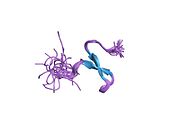Biology:BAFF receptor
 Generic protein structure example |
BAFF receptor (B-cell activating factor receptor, BAFF-R), also known as tumor necrosis factor receptor superfamily member 13C (TNFRSF13C) and BLyS receptor 3 (BR3), is a membrane protein of the TNF receptor superfamily which recognizes BAFF, an essential factor for B cell maturation and survival.[1][2] In humans it is encoded by the TNFRSF13C gene.[3]
Function
B-cell activating factor (BAFF) enhances B-cell survival in vitro and is a regulator of the peripheral B-cell population. The protein encoded by this gene is a receptor for BAFF and is a type III transmembrane protein containing a single extracellular phenylalanine-rich domain. It is thought that this receptor is the principal receptor required for BAFF-mediated mature B-cell survival.[3] In B cell maturation, due to regulation by BAFF-R, only a limited amount of B-cell will survive.[4]
Clinical significance
Overexpression of BAFF in mice results in mature B-cell hyperplasia and symptoms of systemic lupus erythematosus (SLE). Also, some SLE patients have increased levels of BAFF in serum. Therefore, it has been proposed that abnormally high levels of BAFF may contribute to the pathogenesis of autoimmune diseases by enhancing the survival of autoreactive B cells, which are cells that show immune response to normal body cells.[3] Autoreactive B cells are less sensitive toward BAFF and are usually outcompeted by the normal B cells in the maturation process regulated by low BAFF-R expression. An elevated level of BAFF-R can therefore overcome this decreased response and result in accumulation of autoreactive B cells.[4]
BAFF and BAFF-R pair can also down-regulate the cell apoptosis process.[5]
See also
References
- ↑ "BAFF-R, a newly identified TNF receptor that specifically interacts with BAFF". Science 293 (5537): 2108–11. September 2001. doi:10.1126/science.1061965. PMID 11509692. Bibcode: 2001Sci...293.2108T.
- ↑ "Identification of a novel receptor for B lymphocyte stimulator that is mutated in a mouse strain with severe B cell deficiency". Current Biology 11 (19): 1547–52. October 2001. doi:10.1016/S0960-9822(01)00481-X. PMID 11591325.
- ↑ 3.0 3.1 3.2 "Entrez Gene: TNFRSF13C tumor necrosis factor receptor superfamily, member 13C". https://www.ncbi.nlm.nih.gov/sites/entrez?Db=gene&Cmd=ShowDetailView&TermToSearch=115650.
- ↑ 4.0 4.1 "Regulation of B cell self-tolerance by BAFF". Seminars in Immunology 18 (5): 276–83. October 2006. doi:10.1016/j.smim.2006.04.003. PMID 16916609.
- ↑ "Crucial role for BAFF-BAFF-R signaling in the survival and maintenance of mature B cells". PLOS ONE 4 (5): e5456. 2009-05-06. doi:10.1371/journal.pone.0005456. PMID 19421318. Bibcode: 2009PLoSO...4.5456R.
External links
- Human TNFRSF13C genome location and TNFRSF13C gene details page in the UCSC Genome Browser.
Further reading
- "TNF cytokine family: more BAFF-ling complexities". Current Biology 11 (24): R1013-6. December 2001. doi:10.1016/S0960-9822(01)00613-3. PMID 11747837.
- The life and death of a B cell. 86. 2003. 195–225. doi:10.1016/S0065-230X(02)86006-7. ISBN 9780120066865.
- "BAFF-R". Journal of Biological Regulators and Homeostatic Agents 16 (3): 211–3. 2003. PMID 12456020.
- "BAFF, APRIL and their receptors: structure, function and signaling". Seminars in Immunology 18 (5): 263–75. October 2006. doi:10.1016/j.smim.2006.04.006. PMID 16914324. https://serval.unil.ch/resource/serval:BIB_89872BC6E950.P001/REF.pdf.
- "BLyS receptor signatures resolve homeostatically independent compartments among naïve and antigen-experienced B cells". Seminars in Immunology 18 (5): 297–304. October 2006. doi:10.1016/j.smim.2006.07.001. PMID 16919470.
- "Impact of the BAFF/BR3 axis on B cell survival, germinal center maintenance and antibody production". Seminars in Immunology 18 (5): 290–6. October 2006. doi:10.1016/j.smim.2006.06.002. PMID 16931038.
- "The role of the BAFF/APRIL system on T cell function". Seminars in Immunology 18 (5): 284–9. October 2006. doi:10.1016/j.smim.2006.04.005. PMID 16931039.
- "BAFF, a novel ligand of the tumor necrosis factor family, stimulates B cell growth". The Journal of Experimental Medicine 189 (11): 1747–56. June 1999. doi:10.1084/jem.189.11.1747. PMID 10359578.
- "DNA cloning using in vitro site-specific recombination". Genome Research 10 (11): 1788–95. November 2000. doi:10.1101/gr.143000. PMID 11076863.
- "Identification of a novel receptor for B lymphocyte stimulator that is mutated in a mouse strain with severe B cell deficiency". Current Biology 11 (19): 1547–52. October 2001. doi:10.1016/S0960-9822(01)00481-X. PMID 11591325.
- "BAFFled B cells survive and thrive: roles of BAFF in B-cell development". Current Opinion in Immunology 14 (2): 266–75. April 2002. doi:10.1016/S0952-7915(02)00332-1. PMID 11869903.
- "TNFR-associated factor-3 is associated with BAFF-R and negatively regulates BAFF-R-mediated NF-kappa B activation and IL-10 production". Journal of Immunology 169 (12): 6883–9. December 2002. doi:10.4049/jimmunol.169.12.6883. PMID 12471121.
- "Crystal structure of the BAFF-BAFF-R complex and its implications for receptor activation". Nature Structural Biology 10 (5): 342–8. May 2003. doi:10.1038/nsb925. PMID 12715002.
- "Ligand-receptor binding revealed by the TNF family member TALL-1". Nature 423 (6935): 49–56. May 2003. doi:10.1038/nature01543. PMID 12721620. Bibcode: 2003Natur.423...49L.
- "BAFF/BLyS receptor 3 comprises a minimal TNF receptor-like module that encodes a highly focused ligand-binding site". Biochemistry 42 (20): 5977–83. May 2003. doi:10.1021/bi034017g. PMID 12755599.
This article incorporates text from the United States National Library of Medicine, which is in the public domain.
 |





